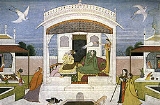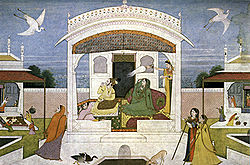
Nishadha Kingdom
Encyclopedia

Nala
Nala , a character in Hindu mythology, is the king of Nishadha Kingdom, son of Virasena. Nala is known for his skill with horses and culinary expertise. He marries princess Damayanti, of Vidarbha Kingdom, and their story is told in the Mahabharata. His main weakness is gambling...
, who loved and married Damayanti
Damayanti
Damayanti , a character in Hindu mythology, was the princess of Vidarbha Kingdom, who married king Nala, of Nishadha Kingdom, and their story is told in the Mahabharata.-The story:...
the princess of Vidarbha Kingdom
Vidarbha Kingdom
Vidarbha kingdom was one among the many kingdoms ruled by Yadava kings in the central and western India, in a region still known as Vidarbha. It was the southern most kingdom known to the kings of Gangatic Plain until they explored Southern India.Damayanti, the wife of Nala was the princess of...
. This kingdom is identified with current day Gwalior district of Madhya Pradesh
Madhya Pradesh
Madhya Pradesh , often called the Heart of India, is a state in central India. Its capital is Bhopal and Indore is the largest city....
. Nishadha was connected to Dasarna
Dasarna Kingdom
Dasarna kingdom was one of the many kingdoms ruled by Yadava kings in medieval central and western India. It lay to the south of the Chedi and Panchala kingdoms, in northern Madhya Pradesh. The Panchala prince Sikhandi married a princess from Dasarna. Sikhandin was alleged to be 'one of the...
and Kosala
Kosala Kingdom
Kosala Proper or Uttara Kosala is the kingdom of the celebrated personality of Treta Yuga, Raghava Rama. Ayodhya was its capital, presently in Faizabad district, Uttar Pradesh. Rama's sons Lava and Kusha inherited parts of this kingdom. Lava ruled from the city called Sravasti and Kusa from the...
as well as with Vidarbha through trade routes.
Connection with the Kuru Dynasty of kings
See Also: Kuru KingdomKuru Kingdom
Kuru was the name of an ancient kingdom in Vedic India, and later a republican Mahajanapada state. The kingdom was located in the area of modern Haryana, Delhi and western Uttar Pradesh in India. They formed the first political center of the of the Vedic India, with its capital at Hastinapur. It...
- Mahabharata, Book 1, Chapter 94
Samvarana begat upon his wife, Tapati, the daughter of Surya, a son named Kuru. He was installed on the throne by his people. It is after his name that the field called Kurujangala has become so famous in the world. Devoted to asceticism, he made that field (Kurukshetra
Kurukshetra
Kurukshetra is a land of historical and religious importance. Historically the land belonged to Punjab now a district in Haryana state of India. It is a holy place and is also known as Dharmakshetra . According to the Puranas, Kurukshetra is named after King Kuru, the ancestor of Kauravas and...
) sacred by practising asceticism there. Kuru’s wife, Vahini, brought forth five sons, viz., Avikshit, Bhavishyanta, Chaitraratha, Muni and the celebrated Janamejaya (Janamejaya the 2nd). And Avikshit begat Parikshit (Parikshit the 1st) the powerful, Savalaswa, Adhiraja (Dantavaktra was a king of the Adhirajas), Viraja, Salmali of great physical strength, Uchaihsravas, Bhangakara and Jitari the eighth. In the race of these were born, seven mighty car-warriors with Janamejaya (Janamejaya the 3rd) at their head. And unto Parikshit (Parikshit the 1st) were born Kakshasena and Ugrasena, and Chitrasena and Indrasena and Sushena and Bhimasena. And the sons of Janamejaya (Janamejaya the 3rd) were Dhritarashtra (Dhritarashtra the 1st)who was the eldest, and Pandu (Pandu the 1st) and Valhika (Vahlika the 1st), and Nishadha and Jamvunada, and then Kundodara and Padati and then Vasati the eighth.
Among them Dhritarashtra (Dhritarashtra the 1st) became king. And Dhritarashtra (Dhritarashtra the 1st) had eight sons, viz., Kundika, Hasti, Vitarka, Kratha the fifth, Havihsravas, Indrabha, and Bhumanyu , and Dhritarashtra (Dhritarashtra the 1st) had many grandsons, of whom three only were famous. They were, O king, Pratipa, Dharmanetra, Sunetra. Among these three, Pratipa became unrivalled on earth. And, Pratipa begat three sons, viz., Devapi, Santanu, and Valhika (Vahlika the 2nd). The eldest Devapi adopted the ascetism. And the kingdom was obtained by Santanu
Santanu
Shantanu was a Kuru king of Hastinapura, who is mentioned in the great epic of the Mahābhārata. He was a descendant of the Bharata race, of the lunar dynasty and the ancestor of the Pandavas and the Kauravas. The Rigveda mentions Shantanu. He was the youngest son of King Pratipa of Hastinapura...
and Valhika.
The history of King Nala of Nishadha
- Mahabharata, Book 3, Chapter 52
There was a celebrated king among the Nishadhas, named Virasena. He had a son named Nala
Nala
Nala , a character in Hindu mythology, is the king of Nishadha Kingdom, son of Virasena. Nala is known for his skill with horses and culinary expertise. He marries princess Damayanti, of Vidarbha Kingdom, and their story is told in the Mahabharata. His main weakness is gambling...
, versed in the knowledge of virtue and wealth. It hath been heard by us that, that king was deceitfully defeated by Pushkara, and afflicted with calamity, he dwelt in the woods with his spouse Damayanti
Damayanti
Damayanti , a character in Hindu mythology, was the princess of Vidarbha Kingdom, who married king Nala, of Nishadha Kingdom, and their story is told in the Mahabharata.-The story:...
.
Nala to Damayanti, on the roads running through Nishadha Kingdom
- Mahabharata, Book 3, Chapter 61
These many roads lead to the southern country, passing by (the city of) Avanti
Avanti
Avanti may refer to:* Avanti , a UK Government sponsored programme to assist construction project partners to work together more effectively...
and the Rikshavat mountains. This is that mighty mountain called Vindhya; yon, the river Payasvini running seawards, and yonder are the asylums of the ascetics, furnished with various fruit and roots. This road leadeth to the country of the Vidarbhas
Vidarbha Kingdom
Vidarbha kingdom was one among the many kingdoms ruled by Yadava kings in the central and western India, in a region still known as Vidarbha. It was the southern most kingdom known to the kings of Gangatic Plain until they explored Southern India.Damayanti, the wife of Nala was the princess of...
—and that, to the country of the Kosalas
Kosala Kingdom
Kosala Proper or Uttara Kosala is the kingdom of the celebrated personality of Treta Yuga, Raghava Rama. Ayodhya was its capital, presently in Faizabad district, Uttar Pradesh. Rama's sons Lava and Kusha inherited parts of this kingdom. Lava ruled from the city called Sravasti and Kusa from the...
. Beyond these roads to the south is the southern country.’ Addressing Bhima’s daughter, he distressed king Nala spake those words unto Damayanti over and over again.
Giriprastha, a place in Nishadha
- Mahabharata, Book 3, Chapter 313
Indra
Indra
' or is the King of the demi-gods or Devas and Lord of Heaven or Svargaloka in Hindu mythology. He is also the God of War, Storms, and Rainfall.Indra is one of the chief deities in the Rigveda...
for the purpose of overcoming his foes, dwelt in disguise in the asylum of Giriprastha, in Nishadha and thus attained his end.
A Mountain Range named Nishadha
- Mahabharata, Book 6, Chapter 6
Stretching from east to west, are these six mountains that extend from the eastern to the western ocean. They are Himavat, Hemakuta, that best of mountains called Nishadha, Nila abounding with stones of lapis lazuli, Sweta white as the moon, and the mountains called Sringavat composed of all kinds of metals.
- Mahabharata, Book 6, Chapter 7
On the south of Nila and the north of Nishadha, there is a huge Jamvu tree that is eternal.
- Mahabharata, Book 6, Chapter 8
On the south of Sweta and the north of Nishadha, is the Varsha (Region or a sub-continent), called Romanaka. The men that are born there are all of white complexion, of good parentage, and handsome features. And the men born there are also all without enemies. On the south of Nishadha is the Varsha called Hiranmaya where is the river called Hiranwati. There liveth the great Garuda
Garuda
The Garuda is a large mythical bird or bird-like creature that appears in both Hindu and Buddhist mythology.From an Indian perspective, Garuda is the Hindu name for the constellation Aquila and...
. And the people there are all followers of the Yakshas, wealthy, and of handsome features. The men there are endued with great strength and have cheerful hearts.
Nishadha, in the list of Kingdoms in Bharata Varsha (Ancient India)
- Mahabharata, Book 6, Chapter 9
..........the Pundras, the Bhargas, the Kiratas, the Sudeshnas, and the Yamunas, the Sakas, the Nishadhas, the Anartas, the Nairitas, the Durgalas, the Pratimasyas, the Kuntalas, and the Kusalas; the Tiragrahas, the Ijakas, the Kanyakagunas, the Tilabharas, the Samiras, the Madhumattas,..........
Nishadhas in Kurukshetra War
- Mahabharata, Book 7, Chapter 20
Drona
Drona
In the epic Mahābhārata, Drona or Dronacharya was the royal guru to Kauravas and Pandavas. He was a master of advanced military arts, including the Devastras. Arjuna was his favorite student. Dronas love for Arjuna was second only to his love for his son Ashwatthama...
sets the troops in Garuda Military Configuration
In the tail of the array stood Vikartana’s son Karna
Karna
Karna or Radheya is one of the central characters in the epic Mahābhārata, from ancient India. He was the King of Anga...
, with his sons, kinsmen and friends, and surrounded by a large force raised from diverse realms, Jayadratha
Jayadratha
In the epic Mahābhārata, Jayadratha was the king of Sindhu Kingdom . He was married to Dushala, the only sister of the 100 Kaurava brothers. He was the son of the sinful king Vridhakshtra.- Abduction of Draupadi:...
, and Bhimaratha, and Sampati, and the Jays, and the Bhojas, and Bhuminjaya, and Vrisha, and Kratha, and the mighty ruler of the Nishadhas, all accomplished in battle, surrounded by a large host, in the heart of that array.
Karna's Military Campaign
- Mahabharata, Book 8, Chapter 8
He had subjugated many invincible and mighty foes—the Gandharas, the Madrakas, the Matsyas, the Trigartas, the Tanganas, the Khasas, the Pancalas, the Videhas, the Kulindas, the Kasi-kosalas, the Suhmas, the Angas, the Nishadhas, the Pundras, the Kichakas, the Vatsas, the Kalingas, the Taralas, the Asmakas, and the Rishikas.

